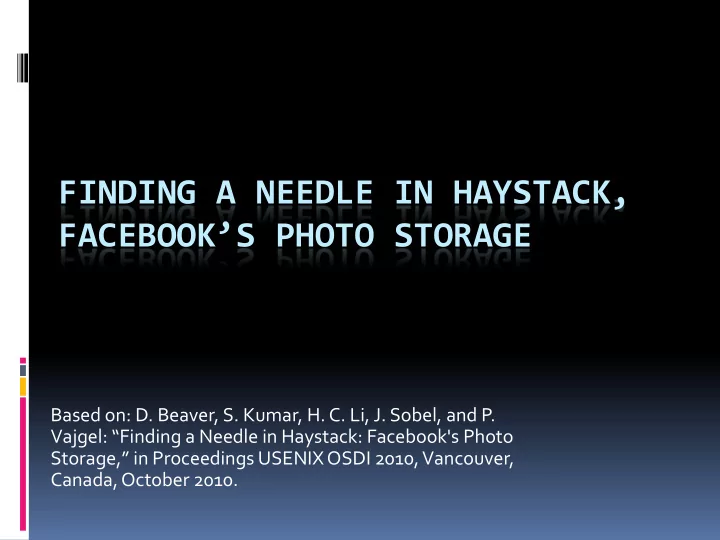

FINDING A NEEDLE IN HAYSTACK, FACEBOOK’S PHOTO STORAGE Based on: D. Beaver, S. Kumar, H. C. Li, J. Sobel, and P. Vajgel: “Finding a Needle in Haystack: Facebook's Photo Storage,” in Proceedings USENIX OSDI 2010, Vancouver, Canada, October 2010.
The problem 65 billion uploaded photos 260 billion images stored (each in 4 copies) 1 billion new photos uploaded each week (~ 60 TB of data) How to deal with that amount of data?
Requirements High throughput and low latency Fault-tolerance Cost-effectiveness Simplicity
Initial design Photos stored as standard UNIX files Requests made to Content Delivery Network (CDN) by the browser Photos fetched from servers via NFS and delivered to end-user by CDN Caching popular photos
Initial design overview
Photo’s popularity
NFS design drawbacks While fetching less popular photos the system has to read the from disk Potentially heavy overhead to find a proper inode (up to several IO operations) IO operation for reading the inode And the user does not want to wait that long…
Improvements Extending photos cache Caching inodes in main memory These are however not effective, as there are too many inodes, which are heavy (for example xfs_inode_t is 536 bytes long)
Solution: Haystack Store multiple photos in a single file Arrange them ‘one after another’ Make the structure that holds photo’s metadata as small as possible Keep these structures in main memory
Haystack design overview: Haystack Store Each store machine manages multiple physical volumes Each physical volume is assigned to a logical one (redundancy for fault tolerance) Each physical volume is a large file (100 GB) that contains many photos Built on top of XFS, every file descriptor opened all the time (but there are just a few files)
Reading a photo
Haystack store: file layout
Haystack store: needle’s metadata
Haystack store: index
Haystack store: index Resides in main memory After reboot can be computed, but this requires reading the hole disk Is updated asynchronously Possible data inconsistency after reboot is also handled
Writing a photo
Haystack directory Maps logical volumes to physical ones Balances reads and writes across physical volumes Determines how to handle a photo request Marks volumes as ‘read - only’ when needed
Further optimizations Deleting photos that users delete (embedding deletion flag in ‘file offset’ field) Batch upload of multiple photos
Evaluation: daily traffic
Evaluation: Read-Only Machines
Evaluation: Write-Enabled Machines
Evaluation 4 times more reads per second (at avarage) with Haystack than with ‘standard’ approach
Thank you, time for questions All graphs taken from the paper, data definition images taken from http://www.facebook.com/note.php?note_id=76191543919 Karol Strzelecki
Recommend
More recommend